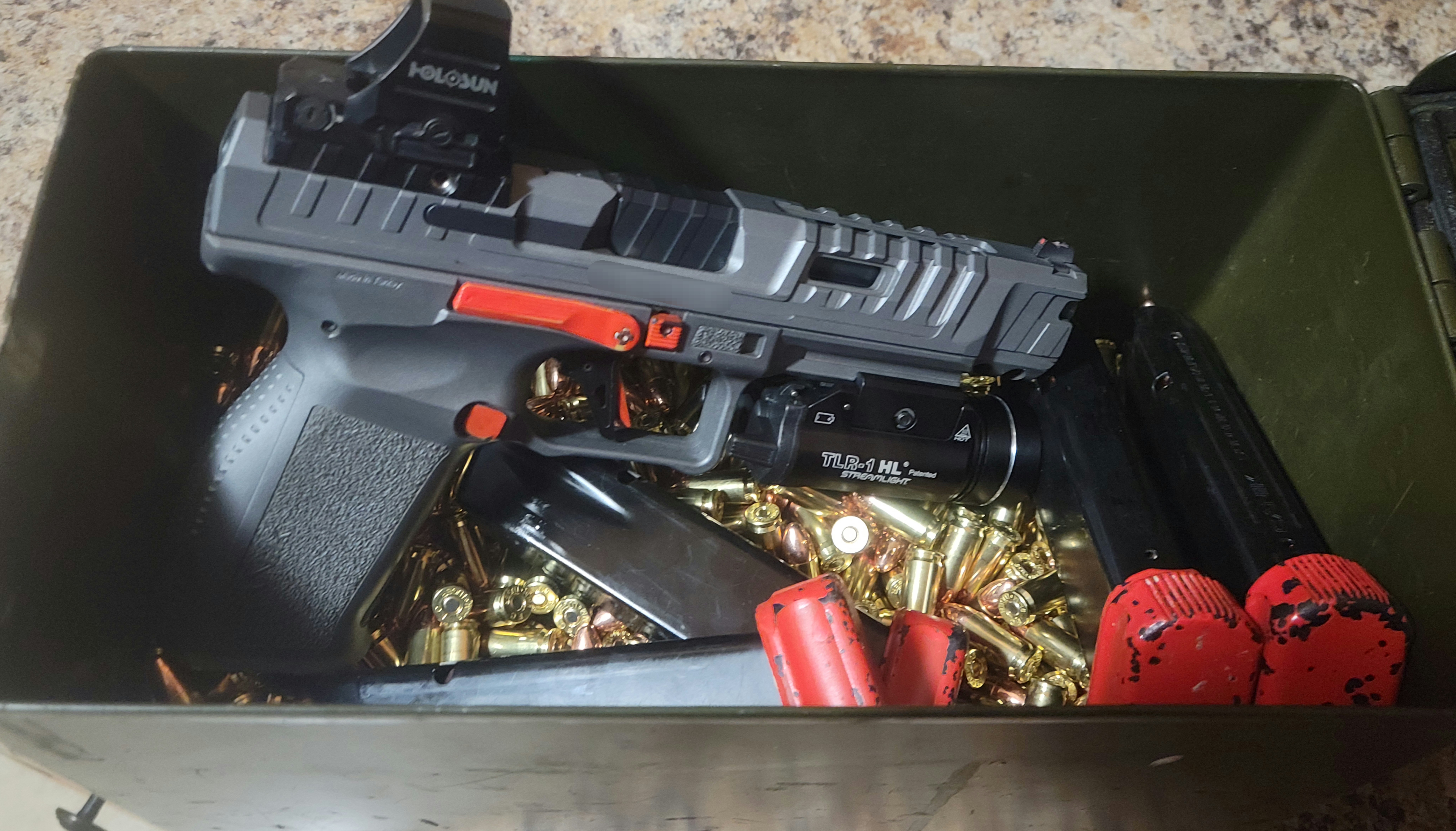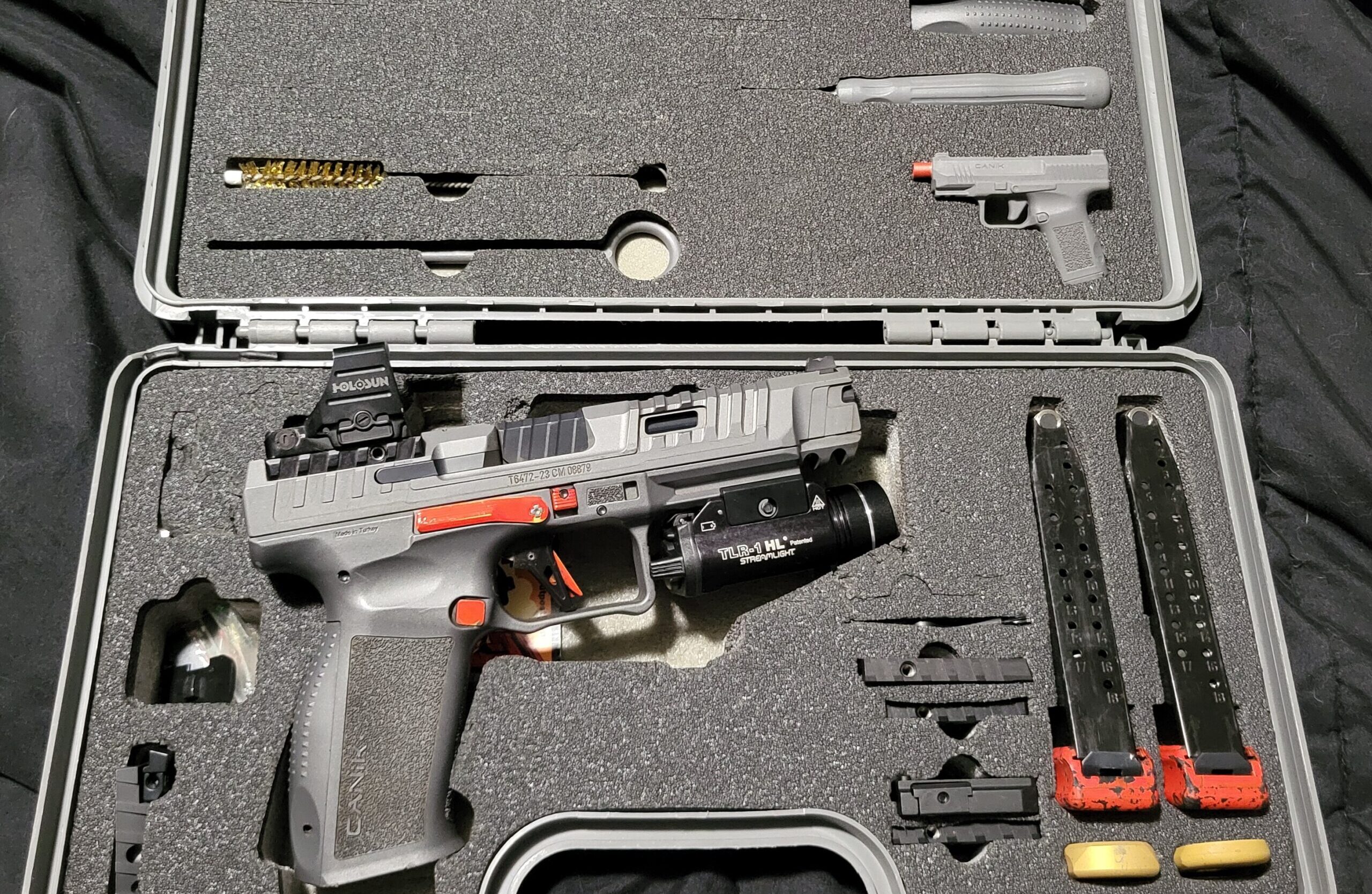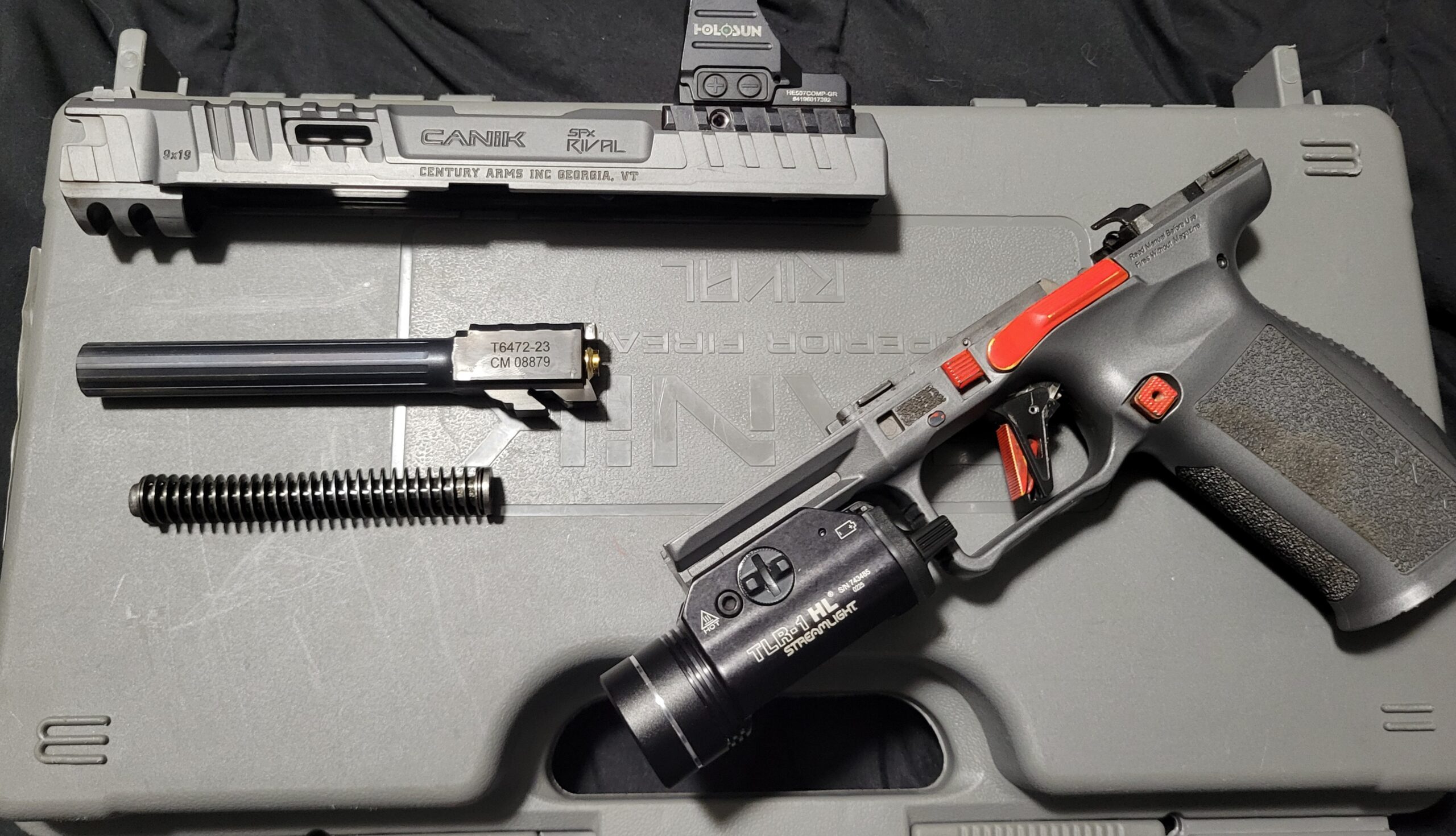Home > Gun Review: Canik Rival SFx

Hey all! 6-1 here with a gun review! Up on the block this month is the Century Arms Canik Rival SFx. Disclaimer: I have no affiliation with Canik or Century Arms. With that out of the way, let’s get to the review!
Why did I buy this gun? I was running a Beretta 92FS in competition–DA/SA–and I didn’t fancy the heavy first round trigger pull or the need to toggle the safety off the buzzer but was in love with the crisp SA trigger pull. On top of that, the 15-round capacity of the 92FS was causing some undesirable, but planned reloads. As a result, I went hunting for a decent striker fired gun. It ended up being between the Walther PDP series and the Canik Rival. After getting 5 rounds down a rental at my local gun range, I was in love. I found my Carry Optics gun.
Canik is a Turkish Aerospace and Defense company that partnered with Century Arms for U.S. Import of arms. Established in 1998 as a result of the Black Sea Arms Project, they are partnered with Lockheed, Boeing, and Airbus, a partnership that allowed them to develop the polymer used in their flagship pistol models. As of 2021, Canik was the 7th largest small arms manufacturer in the world.
So, what’s the overall scoop on this platform? The Canik Rival SFx is an entry level, 9mm only, competition gun boasting a lot of race features in a Carry Optics legal package. The particular model discussed here is the lighter, polymer frame variant. (The -S model is the steel frame variant.) It only comes in 9mm with dimensions of L: 8.1″, W: 1.41″, H: 5.7″, and an unloaded weight of about 29.5 oz. Compared to my 92FS, it’s a light gun, but notably “bigger”. The grey & gold model, along with the Darkside model with no optic included MSRP’s for about 679.99. The optic included variants come in around 850 MSRP, and the color and optic variants anywhere between those prices. I can’t speak to the Mecanik MO2 optic that comes included, but it MSRP’s around 239.99 at the time of writing. Let’s see what’s inside of the box!
Not pictured here in my own box is the removable flared magwell–which must be removed to be CO legal–, however, the following comes in the basic package:




The ergonomics of this gun are my absolute favorite. Note: I have zero modifications to this gun: It is stock, save for the paint and the optic. I’ve put thousands of rounds behind my P365 and 92FS, along with firing a good assortment of other sidearms, this platform feels amazing in my hands. I myself am a smaller guy with smaller hands, and I can get a good, comfortable grip on the platform. Conversely, I’ve talked to individuals with larger hands, and they have no issues achieving the same. The additional backstraps go the distance in really dialing in how you want the platform to fill your hand out. Tearing the gun down to fully clean it is quite simple and can be achieved with a small punch, some needle nose pliers, a mallet, and a small flathead.
Ergonomically, this platform boasts a dual height, ambidextrous magazine release–by removal or addition of a riser pad, installed by default–, ambidextrous and long slide release, a reasonable grip tang angle, and a respectable center of mass. My favorite part of the magazine release that I had consistent issues with on my 92FS is release pressure. Often times I hit my slide release and have to shake the magazine out. The Rival throws magazines out with well sufficient force–although a good Wick Flick never hurt anyone. To this end, the magazine seating feedback is average, but easy to confidently seat with a good push on reloads. I have, in my haste, failed to fully seat magazines, a failure remedied by dry fire practice with magazines full of dummy rounds. A downside to the extended magazine release, is that it’s terribly easy to start with the platform loaded on a table, grab it, and press down hard enough to release the magazine, resulting in a bad start. One can remove the extended pad to help alleviate this at the cost of more required thumb motion, or train around it. I’m choosing to train around it.
The trigger is probably my favorite part of the gun. It’s something people have been making memes about for as long as it’s been out: things like, “That Gucci trigger won’t make you a better shooter!” It won’t, but damn does it feel awesome! The pre-travel–if well cleaned–is smooth all the way through too a solid wall breaking around 3 to 6 lbs.: mine feels to be on the lower end of that, rivaling my 92FS’s 4-6 lb. single action trigger pull. The reset distance, feel, and pressure is equally remarkable. The required force to rack the slide along with the muzzle flip during firing are both acceptably low–but no you can’t punch rack it! So how does it shoot?
Awesome. That’s how this platform shoots. It will work for you if you let it. Work and trust your fundamentals and body, and you will not be disappointed. The muzzle flip and recoil energy are relatively low: I was surprised how quickly my sights got back onto target the first time I fired one. It doesn’t take much to drive the gun and keep it on target. One of the downsides to it being a polymer frame gun, is that being lighter, it does recoil and flip more so than its steel frame counterpart and likely other similarly dimensioned peers.
The trigger pre-travel–again while sufficiently clean–is long enough to allow indecision, but short enough to allow precision. Failure to clean the safety plunger in the slide, the slide release arm, the trigger bar, and the frame where the trigger bar makes contact will result in gritty pre-travel. Ask me how I know. Nevertheless, these things have never affected overall performance. The wall is obvious to feel. If anything, my only complaint is how easy it is to break the trigger. Sometimes I find myself breaking too early on longer distance shots under duress due to loss of fine motor skills, but it hasn’t been a major issue–but something I need to train better!
The one-handed performance of the gun is favorable on account of the lower weight: it’s easier to get a good grip on the platform without shaking, and overall easier to float the gun between your eye and the target than with heavier guns. A good grip and predictable recoil stroke make it easy to get back onto target in that context. Do note however, that as with any gun, limp-wristing will result in ejection malfunction. Overall, single and dual handed, the platform has performed consistently with virtually no issue, aside from when excessively dirty. Reliable is one of the first words I would use to describe this gun. Enjoy some of the following footage of it in action!
If you want to customize this thing, you’ve got options. The Taylor Freelance store provides a battery of customization from magazine base pads increasing the capacity of the stock magazines–I run +2 base pads for 20+1 round start–, to tungsten backstraps to increase grip weight, to custom backplates. The OEM website contains a variety of similar items as well. The platform has a standard 1913 pic rail and gladly accepts the respective underbarrel attachments like dry fire analysis systems and weapon mounted lights. With the abundance of optic plates, the Rival SFx can fit a variety of optics, the more popular RMR footprint included. Custom magwells also exist for that additional flair! Beyond this, from my experience, the gun takes paint well.
If you couldn’t tell by now, I’m a huge fan of this platform. It isn’t perfect–as nothing is–but it most certainly fills the role of a competition gun appropriately. Here’s a quick summary of the pros and cons.
All in all, my final verdict for this gun is a 9/10 for competition purposes. I have yet to have any issue in competition with it that wasn’t the direct result of my own mechanics or lack of cleaning, and I’m still in love with the platform almost a year later. Hope this article helps you make a decision on your next competition gun. Thanks for reading! 6-1 out!
I started off my first USPSA season running the Beretta 92FS–which I still adore–however, I ran into many issues during the competition season. Namely having to toggle my safety during the draw stroke–hard with small hands–, dealing with the super heavy double action trigger pull, and 15-round capacity, which through some weird reloads here and there. After I came to understand the mechanics of a USPSA match and got some skill under my belt, it was time for a new gun that worked a bit better ergonomically for me. The Canik Rival SFx was the answer and I couldn’t be happier with it.
-Devil 6-1